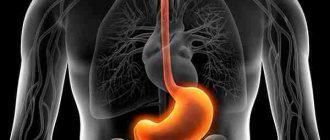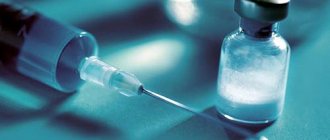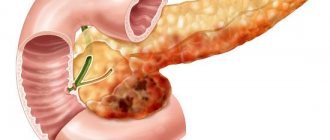Why does your stomach hurt?
Many people “intuitively” understand why their stomach hurts. Before taking painkillers for abdominal pain, it is important to understand where the discomfort is localized. Knowing the location of the source of pain, you can make a preliminary diagnosis, which can then be confirmed by more accurate diagnostic methods.
- If a woman experiences nagging pain in the lower abdomen, then this is most likely so-called menstrual pain, which indicates the onset of menstruation or its imminent approach.
- Sharp pain in or near the belly button may indicate a ruptured appendix. In this case, the patient must be immediately hospitalized in order to check suspicions, since inaction can threaten the life and health of a person.
- If you feel a sharp pain below the navel, then most likely the problem lies in the intestines. If you have diarrhea, bloating, or other unpleasant symptoms, suspicion should fall on the food and water you recently consumed. The accompanying symptoms will help clarify the situation.
- Problems with the gallbladder or duodenum manifest themselves as pain in the upper right area of the abdomen. If there are problems in these organs, pain can also radiate to the lower abdomen and back, which makes diagnosis difficult.
- Pain localized between the navel and solar plexus usually indicates the presence of an ulcer or gastritis, cholecystitis, or inflammation of the pancreas. It usually appears soon after eating.
What should you do if your stomach starts to hurt, but you can’t figure out what the problem is? In this case, you need to call an ambulance (if the pain cannot be tolerated or it lasts more than a day) or visit a gastroenterologist yourself. He will prescribe the necessary examinations to clarify the diagnosis, as well as treatment. Painkillers for abdominal pain may provide temporary relief, but they cannot eliminate the source of the problem.
Symptoms and presumptive diagnoses for pain syndrome
List of diseases accompanied by abdominal pain:
Gastritis
Gastritis is an inflammation of the mucous membrane that covers the stomach. This is most often caused by infection or general irritation.
There are acute and chronic gastritis:
- Chronic gastritis affects not only the superficial layer, but also the deep layers of the mucosa. Most often found in older people. The disease is characterized by aching pain in the pancreas area, sometimes it can be cramping in nature.
For treatment the following is used:
- No-spa for pain relief;
- Almagel;
- Phosphalugel;
- Trimedat;
- De-nol;
- And also vitamin B12.
- Acute gastritis is typical for people with poor nutrition, unhealthy diet, and a lot of stress. Rarely has pronounced pain syndrome. Most often you feel heaviness and fullness in the stomach, nausea, and belching. Occasionally aching pain.
The following tablets are used for treatment:
- Ranitidine;
- Omeprazole;
- Metoclopramide;
- Almagel.
Stomach prolapse (gastroptosis)
Caused by severe weakness of the abdominal wall muscles. With gastroptosis, pain in the pit of the stomach is observed, especially pronounced when overeating, nausea, loss of appetite, weakness, and flatulence. To treat the disease, you must follow a proper diet.
Appointed:
- Mezim;
- Digestal;
- No-shpa is taken to relieve pain in the abdomen.
Stomach upset
Indigestion refers to attacks of diarrhea, nausea, vomiting, and pain in the upper abdomen. Common in people with excess stress, poor diet and digestive problems.
To relieve symptoms, medications such as:
- Maalox;
- Phosphalugel;
- Gaviscon.
Intestinal disorder
A condition characterized by increased gas formation, diarrhea, characteristic pain in the navel, and general malaise.
To help cope with symptoms:
- Loperamide;
- Regidron;
- Activated carbon;
- Linux.
Cholecystitis
Cholecystitis is an inflammation of the gallbladder, most often caused by cholelithiasis.
There are acute and chronic cholecystitis:
Acute cholecystitis
Caused by sudden disturbances in the movement of bile. During attacks of acute cholecystitis, a sharp acute pain is felt in the right hypochondrium, upper abdomen, sometimes reflected in the back (the area of the right shoulder blade), nausea, and vomiting bile.
For acute cholecystitis the following are prescribed:
- Erythromycin;
- Ampiox;
- Analgin;
- Ibuprofen;
- Holagol.
Chronic cholecystitis
Inflammation, accompanied by impaired motor function and the formation of stones. Develops over a long period of time, there is moderate pain in the area of the right hypochondrium, aching. Occasionally there may be cramping attacks of pecking pain, nausea, and vomiting of bile.
Applicable:
- Erythromycin;
- Ampiox;
- No-shpa;
- Magnesia;
- Mezim;
- Olimethine.
Pancreatitis
Pancreatitis is inflammation of the pancreas. There are chronic and acute pancreatitis. Acute pancreatitis is characterized by acute, unbearable pain in the abdominal area. Localized in the right or left hypochondrium, sometimes there is girdling pain.
Symptoms are relieved with:
- Spasmolgon;
- No-shpy;
- Pancreatin;
- Essentiale.
Bile in the stomach
Bile entering the stomach is the first symptom of gallbladder problems. Most often this indicates gallbladder spasms. The main symptoms of this problem are constant thirst, nagging abdominal pain, nausea and vomiting with bile.
The following tablets are used:
- Almagel;
- Motilium;
- Ursofalk;
- No-shpa.
Gastric hernia
A hernia in the stomach is a pathology that occurs mainly in older people. It manifests itself as protrusion of the stomach into the chest cavity through the diaphragm.
You should think about a gastric hernia if you experience frequent belching and heartburn, and aching, burning pain is felt in the upper third of the abdomen and chest cavity. In addition to drug treatment, the doctor prescribes a special diet.
For treatment the following drugs are taken:
- Omeprazole;
- Maalox;
- Gaviscon;
- Famotidine;
- Ranitidine.
Poisoning
Food poisoning is an acute condition. Characterized by the entry of microorganisms into the stomach, most often bacteria. With this condition, nausea, vomiting, chills, stomach pain and a feeling of colic, loose stools are observed.
To alleviate the condition, take:
- Activated carbon;
- Polysorb;
- Smecta;
- Loperamide.
Stomach and duodenal ulcers
A chronic, periodically recurrent disease associated with the formation of defects (ulcers) in the wall of the stomach or duodenum. The main symptom is pain in the upper abdomen, belching, heartburn, thirst, vomiting.
Treatment of ulcers requires an integrated approach:
- Metronidazole;
- De-nol;
- Omeprazole;
- Famotidine;
- Maalox;
- Cerucal;
- No-shpa.
What not to do for abdominal pain
Abdominal pain is one of the most insidious symptoms that can confuse even the most experienced doctor. Therefore, you must adhere to certain rules that will help you timely identify and treat the causes of discomfort.
- Never apply hot heating pads, compresses or other heat devices to the painful area. If there are inflammatory processes in your internal organs (and they are often the causes of pain), then you can only worsen the situation.
- Visit your doctor as soon as possible. Many adults are accustomed to enduring pain and do not attach serious importance to it. But if the pain is very severe and does not go away within a few hours, then you should visit a specialist as soon as possible.
- Painkillers for abdominal pain should not be taken until examined by a doctor. After all, this can seriously complicate the diagnosis of the disease. If you do take a painkiller, be sure to tell your doctor about it.
- Pay attention to accompanying symptoms. If abdominal pain is accompanied by fever, and even more so by vomiting, you should urgently go to the hospital. The cause may be an intestinal obstruction or a ruptured appendix, which requires immediate surgical intervention.
Abdominal pain in children
Although there are serious causes of abdominal pain, “mild” illnesses such as bloating, upset stomach or indigestion are more common. In children, it is almost impossible to know the nature of the pain, so you should very carefully monitor the general condition of the baby. If he eats with appetite, is active and mobile, then there is probably no cause for concern. In this situation, special suppositories with paracetamol or a decoction of dill water, which will improve peristalsis, can help relieve abdominal pain in a child. But if the baby has pale skin, has a fever and is capricious, then it’s worth calling the emergency room. When palpating the abdomen, in this case, worsening symptoms may be observed, and the abdomen itself will be hard and tense. Parents are especially concerned about young children who cannot express what hurts them. Symptoms of abdominal pain in infants usually include pulling the knees toward the chest and constant restlessness and crying.
It turns my stomach what is it
Sometimes the stomach turns due to an intestinal reaction to certain foods. In this case, the functioning of the digestive system, as a rule, normalizes on its own after some time. However, not always, the condition when the stomach twists strongly can go away on its own. Sometimes these symptoms indicate serious reasons for concern.
Important! If your stomach is twisting, but diarrhea does not occur, you should consult a doctor to get examined and rule out the presence of a serious pathology.
In order to understand what could have contributed to the development of the disease, you should first exclude from your diet all foods and drinks that cause nausea and stomach cramps.
Painkillers
Before taking medications that relieve pain, you need to understand which groups they belong to. At the moment, there are several types of painkillers in the world for abdominal pain.
- Enterosorbents effectively help relieve pain from food poisoning. They “recycle” toxic substances, bringing immediate relief. But since enterosorbents are not painkillers in the truest sense of the word, they may not be effective for other diseases.
- Antispasmodics are painkillers for pain in the lower abdomen. During menstruation or diseases of the genitourinary system, they can help relieve unpleasant symptoms. Antispasmodics significantly relieve pain in internal organs by relaxing smooth muscles.
- Non-narcotic analgesics are the most common for pain relief. They do not eliminate the cause of the pain, they simply mask it and also have a strong effect on the liver. Therefore, their use for more than one to three days is strictly not recommended.
- Opiates are used primarily in hospital settings to treat moderate to severe pain. Opiates and narcotic painkillers are often used in cancer patients.
- Non-absorbable antacids help eliminate abdominal pain without affecting other body processes and have an immediate effect. Antacids reduce acidity in the stomach, which has a positive effect on the health of patients suffering from ulcers or gastritis.
Enterosorbents for diarrhea
The use of enterosobrents is considered one of the most effective remedies against diarrhea, which is caused by poisoning. The action of this group of drugs is aimed at absorbing toxic substances that enter the gastrointestinal tract from the outside.
The most popular enterosorbents are:
1) Activated carbon
Activated carbon is one of the cheapest, most accessible and fastest-acting agents. This is a truly “folk” drug, the use of which has many indications. For diarrhea, activated charcoal can be used immediately, since it is indicated for various forms of salmonellosis and dysentery, as well as for non-infectious causes of diarrhea and food poisoning.
Pros:
- Affordable price;
- Time-tested healing effect;
- Possibility of rapid removal of toxic substances from the body;
- Natural base;
- The drug does not have a traumatic effect on the intestines.
Minuses:
- The need to take a large number of tablets at one time;
- Black coloring of stool;
- In addition to toxins, the drug is able to remove its own microflora from the intestines, which is associated with the risk of developing dysbiosis and nutritional deficiencies;
- Long-term use of the drug threatens the development of constipation and exhaustion.
The price of activated carbon is about 50 rubles.
2) Smecta
Smecta (see instructions and reviews), or dioctahedral smectite, is an antidiarrheal agent and absorbent, and it was included in the drug rating as a natural aluminosilicate of natural origin. It, like many other sorbents, is excreted from the body unchanged and does not enter into metabolism. It is used in both children and adults for acute diarrhea and chronic diarrhea of various origins, including infectious. It is also successfully prescribed for bloating and discomfort in the abdomen.
Smecta should be used by an adult in the amount of 6 sachets per day. Treatment is carried out between meals, and separately from taking other medications. You can purchase 12 sachets, packaged in 3 g each in the form of a suspension for oral administration, at a price of 220 rubles. The manufacturer of the product is French.
Pros:
- High adsorbing properties;
- Ease of use;
- Pleasant taste;
- Possibility of treatment in childhood;
- Effective for diarrhea of almost any origin;
- In addition to stopping diarrhea, Smecta helps eliminate other unpleasant symptoms, such as heartburn and abdominal pain.
Minuses:
- Relatively high price of the drug;
- The likelihood of skin rashes, especially in childhood.
Smecta's price is about 170 rubles.
3) Polysorb
Polysorb is produced on the basis of colloidal silicon dioxide, which has powerful absorbent and detoxifying properties.
Available in powder form, from which a suspension is prepared before administration. Polysorb is prescribed for intestinal infections of various etiologies, accompanied by diarrhea, nausea, vomiting and other symptoms of intoxication. Restrictions on the use of the drug are acute peptic ulcer disease, gastric bleeding, intestinal atony, and individual intolerance.
For children under seven years of age, the dose of the drug is 150 milligrams per kilogram of body weight. For adults, the daily dose of Polysorb is 12 grams. The duration of treatment is from three to seven days. If necessary, it can be continued for up to two weeks.
Price – from 280 rubles.
The most effective painkillers
Every person who has experienced abdominal pain does not want it to happen again. It can be extremely painful and unpleasant, and can also occur in the most inappropriate places. What can cope with these unpleasant sensations? Here is a list of the most common and effective medications:
- “No-shpa” is a pain reliever for abdominal pain during menstruation and other smooth muscle spasms. Sold in any pharmacy without a prescription, the cost is 120 rubles for 24 tablets. However, this medicine has one feature - “No-spa” lowers blood pressure. Therefore, it is not recommended for hypotensive patients and pregnant women.
- "Omez" has proven itself as an effective drug for abdominal pain caused by ulcers, gastritis, reflux or inflammation of the duodenum. The price at the pharmacy is about 270 rubles for 30 capsules. You can take the medicine either in courses or as needed.
- "Spazmalgon" is a strong pain reliever for abdominal pain. It has not only an antispasmodic, but also a mild anti-inflammatory effect on the body. The price for a package of 20 tablets is 151 rubles.
- "Pentalgin" has a powerful analgesic and anti-inflammatory effect. The drug contains several active substances: paracetamol, caffeine, drotaverine, naproxen. They have a complex effect and quickly eliminate pain. A package of this medicine will cost you 180 rubles.
- "Cerucal" copes well with one of the most common causes of abdominal pain. It improves intestinal motility and eliminates flatulence. You can buy it for 120 rubles.
- "Creon", "Pancreatin" and other enzyme medications improve digestion and intestinal motility. They act immediately, but it is advisable to use them during meals. Therefore, if you feel discomfort in the abdomen during a meal, it is better to immediately resort to the help of one of these drugs.
- “Smecta” and “Enterosgel” help the body cleanse itself of toxins and waste, and at the same time eliminate pain caused by poisoning or diarrhea. Relief will not come immediately, but you will not feel any side effects from taking it.
At the moment, pharmacies offer a wide range of different medications that help cope with abdominal pain. Their cost does not exceed 200 rubles, which means that they are accessible to a wide range of the population. When choosing a pain reliever for abdominal pain, you should be guided by the cause of the discomfort. Then the treatment will be quick and the effect will be lasting.
What pills help adults with stomach pain?
It is important to understand that if you have abdominal pain, it is not recommended to relieve it with medications until a diagnosis is made. But in cases where the cause is easily determined, you should know which medications can alleviate the condition.
For cramps and colic
Cramps and colic are symptoms of many diseases. In order to reduce pain, it is recommended to take antispasmodics. These medications quickly relieve spasms of the smooth muscles of internal organs. This can significantly improve the condition, but it should be remembered that these drugs retain their effect for a short time. No-spa is considered the most effective drug. The active component in it is drotaverine, which is capable of relaxing the muscles of the gastrointestinal tract, biliary tract and genitourinary system for a short time. The product should be taken strictly according to the instructions. The tablets should not be used for a long time. If the pain cannot be reduced, it is recommended to call an ambulance. Intramuscular injections are allowed only as prescribed by a doctor.
To relieve spasms and colic, it is recommended to take the following medications:
- Spasmalgon
, which additionally has anti-inflammatory properties. - Metoclopramide
, which can normalize intestinal motility and block specific brain receptors. - Ranitidine
, which is indicated if cramps are caused by digestive diseases such as gastritis or stomach ulcers. - Omez
, capable of eliminating painful spasms that arise against the background of increased stomach acidity during the development of gastritis.
For bloating and increased gas formation
Very often the cause of abdominal pain is flatulence and increased gas production.
For abdominal pain for this reason, you can take medications belonging to different groups.
- Enterosorbents
that are capable of absorbing excess gases. The most famous is activated carbon. It is taken at the rate of 1 tablet per 10 kg of weight an hour before meals or some time after meals. Smecta has a more pronounced effect. It is produced in the form of a powder, which is used to prepare a solution. An effective remedy is Lactofiltrum, which is allowed to be used even for intestinal obstruction. In the shortest possible time, this drug not only removes bloating, but also relieves dysbiosis. Usually take 2 tablets 3 times a day an hour before meals. - Carminatives
, which are characterized by the fact that they collapse small air bubbles in the intestines, thereby accelerating their removal from the body. The most famous drug in this group is Espumisan. Capsules can be taken for a long time, unless hypersensitivity to the active substance is observed and intestinal obstruction is not diagnosed.
- Prokinetics
, which can enhance intestinal motility. By improving peristalsis, excess gases are removed from the body faster, which eliminates the occurrence of discomfort. The most famous drug is Motilium. Additionally, the tablets can relieve nausea, which often accompanies increased gas formation.
- Probiotics and prebiotics
, which are able to restore normal intestinal microflora, eliminating the cause of discomfort. At the same time, probiotics contain strains of beneficial bacteria, and prebiotics consist of components that can support the proliferation of normal bacteria in the intestines. Linex is considered the most effective drug, which helps to cope with a variety of digestive disorders. Lactofiltrum is also often prescribed, in which an additional component is a sorbent.
- Enzyme preparations
, which are used when there is insufficient production of digestive enzymes, which impairs the digestion process, and therefore increases the risk of increased gas formation. Mezim forte is most often prescribed, its analogue is Pancreatin or Festal. The tablets improve the functioning of the pancreas and improve digestion processes. The dosage is selected individually.
For diarrhea (from diarrhea)
Diarrhea can occur for various reasons. And because of this, various drugs can be used to treat it. If diarrhea occurs against the background of an intestinal bacterial infection, then antibiotics are prescribed for treatment (for example, Levomycetin
). The tablets have a pronounced antimicrobial property. The medicine allows you to successfully fight most pathogenic organisms in the intestines. However, most of them do not develop resistance to the drug.
The manifestations of diarrhea can be reduced with drugs that slow down intestinal motility. Loperamide is very effective
.
After taking the product, relief comes quickly. A characteristic feature of the drug is that it stops diarrhea regardless of the cause. Imodium
has a similar effect .
In order to normalize stool, it is necessary to restore the natural intestinal microflora, disturbed by various diseases of the gastrointestinal tract. For this purpose, probiotics are used, which contain beneficial bacteria. The most famous are Linux
,
Bifidumbacterin
,
Bifikol
,
Hilak forte
. If diarrhea occurs due to food poisoning, then enterosorbents are mandatory drugs for treatment.
For constipation
Laxatives help relieve abdominal pain and constipation. The most effective are tablets that are made on a plant basis. But it should be understood that frequent constipation requires mandatory examination in order to make an accurate diagnosis.
The most commonly used tablets for abdominal pain and constipation are:
- Senade
. The active substances in this drug have an irritating effect on the muscles of the large intestine. This provides a laxative effect. The tablets cannot be taken for a long time, and the drug is also contraindicated for intestinal obstruction, ulcerative colitis and various inflammatory diseases of internal organs. - Bisacodyl
, which can be used as an emergency relief for constipation. With long-term use there are risks of unwanted complications. This drug is often used to cleanse the intestines before surgery. - Phytolax
. The drug is produced on the basis of exclusively plant components. It has a mild laxative effect and is able to normalize digestive processes. You are allowed to take the tablets for two weeks. - Poslabin
. The drug is a very mild laxative and is often used before various diagnostic procedures. This safe medicine can be used even by children.
In inflammatory processes
For inflammatory processes that are accompanied by severe pain, it is allowed to take non-steroidal anti-inflammatory drugs. Such tablets have a pronounced analgesic property, but at the same time they can have a negative effect on the mucous membrane of the digestive tract. Doctors usually recommend using them once to eliminate intense abdominal pain caused by inflammatory processes. The most popular drug is Ibuprofen
.
In addition, analgesics quickly help relieve pain, regardless of its etiology. The peculiarity of the drugs is that they begin to act very quickly. After a quarter of an hour, relief is already observed. The most commonly used is Analgin
,
Baralgin
and
Tempalgin
.
For chronic exacerbations
If there is an exacerbation of diseases of the intestines, biliary tract or kidneys, then severe pain often occurs.
The following tablets help with abdominal pain that is associated with exacerbation of such diseases:
- Spazgan
. This is a combined remedy that includes an analgesic and an antispasmodic. - No-spa
, the action of which is aimed at relieving smooth muscle spasms caused by exacerbation of various pathologies. - Xefocam
. This drug additionally has anti-inflammatory properties and an antiseptic effect.
For abdominal pain that is accompanied by heartburn, medications that reduce stomach acidity help. This is Rennie
,
Gastal
,
Ranitidine
,
Rutacid
and
Omeprazole
. The combination drug Bellastesin is also considered effective. It relieves spasms of the intestines and bile ducts, and also relieves heartburn during gastritis, which develops against the background of increased acidity of gastric juice.
In case of poisoning
In case of food poisoning, medications for abdominal pain can only be taken as prescribed by a doctor. Self-treatment can be very harmful. For all types of food poisoning, sorbents are always prescribed that can relieve intoxication syndrome and reduce the manifestations of diarrhea. Against this background, the pain syndrome is significantly reduced. An effective sorbent is Smecta
.
It additionally has an enveloping effect. Also often prescribed for poisoning is Polyphepan
, which is made from wood and is capable of eliminating chemical irritants and toxins of various origins.
Enzymes that improve digestive processes are also considered tablets for stomach pain in case of poisoning. They are taken with meals. Effective drugs are Mezim forte
and
Festal
.
If intestinal colic occurs due to poisoning, then spasms can be relieved with the help of antispasmodics. No-shpa
is most often prescribed .
If the poisoning is bacterial in nature and caused by some kind of intestinal infection, you cannot do without antibiotics. In a short time it can relieve the symptoms of poisoning and help with abdominal pain. Ciprofloxacin
, which belongs to the group of fluoroquinolones.
Levomycetin
is also often prescribed , which is able to fight various types of bacterial infections in the intestines.
Very often, pain during poisoning is caused by vomiting. In this case, antiemetics will help relieve abdominal pain. Domrid is considered a very effective drug
. Tablets are taken 3-4 times a day, but it should be noted that they have certain contraindications.
For injuries and bruises
With injuries and bruises of the abdomen, as a rule, acute pain occurs. As a result, the use of painkillers cannot be avoided, but their use must be agreed upon with a doctor.
Today, the most popular painkiller is Ibuprofen
. There are many analogues of it. The analgesic effect is observed almost immediately, with significant relief occurring within a quarter of an hour. But at the same time, you need to remember that the drug cannot be taken for a long time, as it negatively affects the organs of the digestive system.
Ketanov is a strong analgesic
.
It is able to relieve pain that occurs in the abdomen for a variety of reasons, including due to abdominal bruises. But you should remember that an overdose can have dangerous consequences. If pain from bruises and abdominal injuries is moderate, then the most harmless remedy for eliminating them is Paracetamol
. But its peculiarity is its short-term effect - no more than 4 hours.
Unreasonable pain (when there is no exact diagnosis)
When causeless abdominal pain occurs, you should stop taking any painkillers until the cause of the pain is determined. But sometimes the pain is so severe that it becomes necessary to take painkillers.
These may be the following tablets:
- No-spa
, which is a myotropic antispasmodic agent. The drug can relieve abdominal cramps and lower blood pressure. - Spasmalgon.
This is a combination drug that contains anti-inflammatory antispasmodic components. Thanks to it, you can quickly reduce pain of various etiologies. - Metoclopramide
. This is a centrally acting drug that is able to restore intestinal motility by blocking specific receptors in the brain. Thanks to it, you can quickly eliminate nausea and vomiting. - Ranitidine
. The drug is able to relieve pain caused by increased acidity of gastric contents. The medicine also effectively copes with the urge to vomit. - Omez
, which belongs to the group of antacids, can quickly reduce acidity in the stomach. The drug is effective if pain is caused by pancreatitis, as well as various diseases of the digestive system. - Cerucal
. The drug can quickly stabilize intestinal motility, eliminate vomiting and suppress excessive gas formation.
Medicines for children
Children have different needs than adults, so for abdominal pain you need to use medications with extreme caution. After all, out of ignorance, you can not help, but harm the baby. What painkillers should be used for children with abdominal pain? The main cause of discomfort in the abdominal area in a child under one year of age is the characteristics of the immature digestive system. Spasmodic contraction of the intestinal muscles can cause severe pain, and gas can bloat the abdomen and intensify the spasm. In this case, analgesics, which are available for small children in the form of suppositories, can bring quick relief. They usually contain paracetamol or ibuprofen. Pain-relieving suppositories for abdominal pain in children quickly relieve pain: young patients feel better within 10-15 minutes. To prevent recurrent spasms, doctors recommend using prebiotics and enzymes to improve digestion.
However, it is not recommended to prescribe such drugs without diagnosis and a preliminary examination by a doctor, because the baby still cannot tell exactly where it hurts. If no serious violations have been identified, and the doctor has authorized the use of pain-relieving suppositories for pain in the lower abdomen or in another part, it is recommended to purchase one of the following drugs in rectal form:
- "Ibuprofen" - contains the active substance ibuprofen, which affects the nerve endings in the internal organs.
- "Cefekon" - a medicine based on paracetomol, has a similar effect.
- "Viburkol" is a homeopathic remedy that can be used even in the youngest patients without consulting a specialist.
Painkillers for pregnant women
Pregnancy is a special condition for a woman, during which you need to pay all your attention to health. Therefore, if you begin to experience abdominal pain, especially in the lower part, you need to consult a doctor as soon as possible or even call an ambulance. However, there are a number of unpleasant symptoms that do not pose a serious danger. For example, pregnant women often suffer from indigestion and heaviness after eating certain foods. With chronic diseases of the internal organs (inflammation of the pancreas, pancreatitis or ulcers), from time to time a woman may also experience painful attacks. There is no need to endure them, since pain negatively affects the body of the mother and child. If you know exactly the source of the pain and are sure that it does not pose a danger to your health, you can take a pain reliever. But what medications are allowed during pregnancy?
The use of most analgesics and antispasmodics during pregnancy is prohibited. After all, the active substances contained in such medications can negatively affect the development of the child and even cause premature birth due to relaxation of smooth muscles. Therefore, doctors recommend using the following drugs:
- Paracetamol - compared to its analogues (Analgin and Aspirin), this medicine has the least side effects. But still, Paracetamol has a toxic effect on the body, so only a doctor can prescribe the dosage.
- In the first trimester of pregnancy, it is allowed to take non-steroidal anti-inflammatory drugs such as Ibuprofen. In the second and third trimester, their use is limited, as they can cause a number of pathologies in the child.
- Topical anesthetic ointments based on diclofenac and ketorolac are approved for use in the first two trimesters.
What does abdominal pain and diarrhea indicate?
Stomach pain and diarrhea, stomach cramps, upset digestion often occur due to a lack of digestive enzymes in the body.
It is necessary to distinguish in which case home treatment will help stabilize the situation, and when you need to see a doctor so as not to miss the development of the problem.
Safe Reasons
- Inability to digest milk. The problem occurs after consuming the product: diarrhea occurs, the stomach turns, and gases accumulate in the intestines. The disorder goes away on its own. To reduce the risk of recurrence of this situation, milk is excluded from the diet.
- Loose stools and bloating occur in women before menstruation. This factor is not associated with the development of pathology.
- Pregnancy is a period during the first trimester of which women experience periodic diarrhea.
- If your stomach hurts and you have diarrhea, this may indicate a state of stress. General weakness, dizziness, chills, and stomach cramps may occur. An unpleasant belching and burning sensation appears in the stomach. Treatment is aimed at stabilizing the psychological state.
- Improper nutrition provokes digestive system disorders and upsets the stomach. A person does not receive the necessary vitamins and microelements contained in food. This leads to intestinal dysfunction.
- Binge eating. Nausea, vomiting, and diarrhea disappear when nutrition is normalized. People who suffer from gluttony face a problem.
- Food poisoning. The consumption of low-quality products leads to disruption of the gastrointestinal tract. The malaise is short-term. During this period, it is recommended to drink plenty of fluids to prevent dehydration.
- Diarrhea may occur during the acclimatization period. This depends on the change in the composition of the water. There is cramping pain and frequent urge to defecate.
- Diarrhea may be a consequence of alcoholic libations.
Diseases and conditions requiring doctor's attention
In some cases, loose stools are a symptom indicating pathology. In the absence of timely help, a person is at risk.
We recommend reading
- Treatment of neurogenic diarrhea
- Effects of jelly on the functioning of the stomach
- Can a nursing mother get dehydrated from diarrhea?
- Rotavirus is a disease transmitted through dirty hands and airborne droplets. The first symptom is vomiting, the temperature may rise or remain normal, and the patient experiences chills. Diarrhea is a typical sign of the disease. The urge can be one-time or frequent. The discharge becomes watery, foamy, and changes color from yellow-green to pale. Pain and burning occurs in the navel area. The severity depends on the age and immunity of the person; not everyone needs the help of a doctor, but usually it cannot be done without the intervention of a specialist. During this period, you need to drink a lot of water due to the risk of dehydration.
- Diarrhea and stomach cramps are often a sign of helminthic infestation. It is often impossible to stabilize the condition on your own. Testing and taking antihelminthics are required.
- If diarrhea is accompanied by chills, fever, headache, weakness, and the situation does not stabilize within 1-2 days, diagnostics and antipyretic medications are required.
- It is forbidden to try to relieve spasms or cutting pain at home. These processes are a signal of serious health problems. The diagnosis is made by a doctor after the necessary examination.
- Bloody diarrhea with mucus indicates damage to internal organs; the intestine may be injured.
- Pain in the chest, pallor of the skin, rapid heartbeat, heavy sweating, diarrhea, cramping in the abdomen - signs of disturbances in the functioning of the cardiovascular system, may indicate a pre-infarction condition.
Tablets for painful menstruation
Most women have experienced menstrual syndrome at least once in their lives. Due to the increased production of estrogen and progesterone, patients often complain of headaches, discomfort in the lower abdomen and general poor health. How to relieve pain in the lower abdomen? If you are experiencing severe pain before or during your period, then only a specialist can help after conducting a series of tests. Perhaps the problem lies in a hormonal imbalance or in another part of the body. If the pain is not a periodic phenomenon, then non-steroidal anti-inflammatory drugs can relieve it. The most popular among them are the following medications:
- "Ketoprofen".
- "Naproxen."
- "Ibuprofen."
It is important to remember that these drugs are not recommended for pain localized above or near the navel, and the course of use should also be limited to three days. If the pain does not go away within this time, you should consult a doctor. But there are patients who do not benefit from non-steroidal anti-inflammatory drugs. In this case, you can try other painkillers for pain in the lower abdomen - analgesics:
- "Ketonal".
- "Analgin."
- "Ketanov."
In addition to analgesics and non-steroidal anti-inflammatory drugs, there are antispasmodics, which are also very effective as pain relievers for lower abdominal pain in women. These are such well-known drugs as “Spazmalgon”, “No-shpa”, “Papaverine”. These medications are not recommended for pregnant women, people with low blood pressure or kidney failure. How to take painkillers for abdominal pain during menstruation? To eliminate even strong unpleasant sensations, it is enough to take 4-6 No-shpa tablets or one Spazmalgon tablet. This will temporarily relieve the pain, but after a few hours it may reappear.
Taking pills depending on the situation
Although there are universal remedies, it is best to try to determine the nature of the pain so that the selected tablets help fully.
If the painful sensations are constant, then you should not suppress them with analgesics, but identify and eliminate the cause.
For painful menstruation
For some women, the first days of the cycle are accompanied by severe pain in the lower abdomen, associated with uterine contractions during menstruation and hormonal changes.
It is best to use antispasmodics if the pain is moderate, or combined drugs if the first group of drugs does not cope with its task. Tablets that are best used during menstrual periods:
- No-shpa;
- Nurofen Lady;
- Nalgesin;
- Trialgin;
- Spasmalgon;
- Pentalgin.
In particularly severe cases, some are helped only by drugs based on ketorolac or nimesulide:
- Ketorol;
- Ketanov;
- Nise;
- Nimika.
They are much more powerful than other means, but also more dangerous if used uncontrolled and for a long time. It is advisable that these drugs be prescribed by a doctor, since they have a bad effect on the gastrointestinal tract and are prescription drugs.
When overeating
Acute pain in the stomach is associated with stretching of its walls.
In addition to pain, nausea, a feeling of fullness, belching, and gas formation usually occur. Painful sensations may also be due to the fact that the stomach begins to compress neighboring organs. Drugs that eliminate all of the above symptoms:
- Trimedat;
- Motilium;
- Meteospasmil.
You can use enzyme preparations that help speed up digestion, as a result of which the pain goes away faster:
- Festal;
- Mezim;
- Creon.
It is best to take these tablets during meals or immediately after, without waiting for symptoms to occur.
In case of poisoning
When pain is accompanied by diarrhea and intestinal spasms, it is recommended to take antispasmodic drugs, which additionally affect the restoration of stool, normalizing intestinal motility:
- Duspatalin;
- No-shpa;
- Meteospasmil.
If nausea and vomiting are present, you can take drugs based on domperidone or metoclopramide:
- Motilium;
- Motilak;
- Cerucal.
Be sure to read:
Intestinal dysbiosis in children: symptoms and treatment (diet, medications)
They should be taken with a small amount of water to avoid vomiting. It is preferable to choose Motilium in the form of soluble tablets.
For gastritis
Antacids are best for relieving pain due to erosive gastrointestinal lesions. They coat the esophagus and stomach, soothe the mucous membrane and neutralize acid. But they are only a short-term solution to the problem, they are used as a temporary measure:
- Gastal;
- Maalox;
- Rennie;
- Gaviscon.
A significant disadvantage of such drugs is the “rebound syndrome” - painful sensations can intensify after the drug wears off. Plus, they help quickly and reliably.
The drug Becarbon has an antispasmodic and antacid effect. It is indicated for hyperacid gastritis, when pain occurs due to increased acidity.
When to call an ambulance
Abdominal pain can be caused by a serious malfunction of the internal organs or their inflammation. For example, if we are talking about sudden intestinal obstruction, the clock can count. Therefore, it is so important to know the “bad” signs of abdominal pain and be able to provide first aid.
- The abdominal muscles are overly tense, they cannot be pressed or felt, and any touch causes acute pain.
- Unpleasant sensations are accompanied by urinary retention.
- The patient is bleeding.
- The pain was preceded by an injury.
- The temperature exceeds 38 degrees.
- There is pallor of the skin, the person is unclearly aware of the surrounding reality or is unconscious.
If a person experiences one or more of the above symptoms, it is necessary to urgently call for medical help. Most likely, the patient will be examined in a hospital, where underlying diseases will be excluded using diagnostic and laboratory tests. Strong painkillers for abdominal pain can dull symptoms and prevent a correct diagnosis.
My stomach is churning but I have no diarrhea, nothing to drink
Abdominal pain, accompanied by diarrhea, vomiting, and increased body temperature, indicate a developing pathology, and the situation when the stomach turns without diarrhea confuses many.
If a patient, regardless of age, has pain and cramps in the abdomen, but does not experience other symptoms, such as loose stools, this may indicate eating incompatible foods or a violation of the diet.
In this case, experts recommend taking a drug from the following list:
- activated carbon has a pronounced adsorbing effect; if the dosage is calculated correctly, relief occurs within a few minutes;
- in cases where the source of discomfort is stretching of the intestinal walls due to increased gas formation, experts recommend taking Espumisan, a drug whose active ingredient is simethicone; to relieve pain, you can take antispasmodics such as No-Shpa, Spazgan, etc.;
- if you overeat or eat unusual foods, you should take a medicine that contains enzymes, for example, Festal, Pancreatin, Mezim; in the case when the stomach hurts, twists, loose stools, nausea, flatulence appear, the cause of discomfort is dysbacteriosis, the patient is prescribed Hilak-Forte, Enterofuril and other drugs that restore intestinal microflora. It is important to remember that the drugs listed are intended to alleviate the patient’s condition.
You cannot make appointments for yourself. If the cause of discomfort is indigestion, you must refrain from eating for a day. In cases where abdominal pain and diarrhea are caused by intoxication, you should consult a doctor.
In any case, it is worth drinking activated carbon. It won't cause any harm anyway. Activated carbon is a good adsorbent that will eliminate all dyspeptic disorders in the intestines.
Additional examination methods
What are the main examination methods to determine the cause of abdominal pain?
- Examination by a gastroenterologist, surgeon or gynecologist.
- Anamnesis collection.
- Ultrasound of internal organs.
- CT scan.
- X-ray with contrast.
- Blood and urine tests.
- Biochemical research.
- Histological studies.
Most diseases are detected after examination and blood tests. The most common after laboratory tests are ultrasound examinations. An X-ray with contrast is done if intestinal obstruction is suspected. In some cases, it is necessary to resort to surgical methods of examination. For example, a ruptured appendix cannot always be determined in any other way. In this case, a laparoscopic operation is performed, during which the integrity of the internal organs is examined through tiny incisions.
Traditional methods
Not only medicinal painkillers for abdominal pain can help the patient. There are many folk remedies that effectively treat discomfort. What painkillers for abdominal pain can be made from natural ingredients? Rice water with fennel helps to improve peristalsis. The thick drink coats the intestinal walls and acts no worse than pharmaceutical drugs. Ginger decoction can solve the problem of constipation and impaired peristalsis. The root of the plant increases the production of digestive juices and acts as a mild pain reliever. For gastritis or stomach ulcers, potato juice with honey has a good effect. To prepare it, you need to grate the potatoes and strain the resulting mixture. For a more pleasant taste, you can add honey. The starch contained in potatoes coats the walls of the stomach and relieves discomfort. A decoction of chamomile leaves with plantain has a healing and anti-inflammatory effect. Therefore, it is drunk for ulcers and stomach erosion. Folk remedies for abdominal pain help well in mild cases. But if the pain does not go away for a long time and other unpleasant symptoms are added to it, you need to consult a doctor.
What to do and how to treat
If there is a serious pathological cause, consult a doctor. You can help yourself if you are sure that the problem is due to overeating or indigestion.
Drink activated carbon. This is an adsorbent that will eliminate intestinal disorders.
A stomach problem can be quickly resolved if it is not caused by health problems. The drugs will rid the body of toxins that appear due to fermentation and rotting food.
If you feel heaviness and discomfort in the abdomen after eating a product, then you should remove it from your diet.
If you experience abdominal pain while eating food, you should drink half a glass at room temperature.
Remove spicy, fatty and salty foods, seeds, halva and alcohol from your diet.
If your stomach is twisting, there is no diarrhea, but there is acute pain in the abdomen, a fever, or other discomfort, then make an appointment with a doctor for a diagnosis and treatment.
Results
Abdominal pain bothers many people. Unpleasant sensations can be caused by various reasons, but most of them can be removed with medications. Painkillers for abdominal pain in adults are not always safe, because they can mask serious illnesses. However, if you understand the location of the pain and can determine its source, pain medications may provide temporary relief. It is important not to forget to visit a doctor and eliminate the original source of discomfort.
What to drink from tablets
If you have eaten a lot of food and your stomach is swollen, flatulence and increased gas formation appear, then take Espumisan. It comes in tablets, capsules and suspensions.
No-shpa
No-shpa will help with pain after eating, cramps and abdominal pain.
Mezim
Discomfort after eating will be eliminated by Mezim. This is an enzyme preparation for the treatment of infections in the intestines and abdominal pain.
Smecta
Smecta will help remove toxins from the body and relieve stomach discomfort. The drug protects, envelops and soothes the gastric mucosa. Can be used by adults, children and pregnant women.










